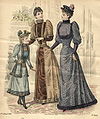Asia Under Girls 044
Conversely, in certain cultures which link family honor with female virginity, the word girl is still used to refer to a never-married woman; in this sense it is used in a fashion roughly analogous to the obsolete English maid or maiden. Referring to an unmarried female as woman may, in such a culture, imply that she is sexually experienced, which would be an insult to her family.
In some settings, the use of girl to refer to an adult female is a vestigial practice (such as girls' night out), even among some elderly women. In this sense, girl may be considered to be the analogue to the British word bloke for a man, although it again fails to meet the parallel status as an adult and the only true American English parallel to girl is boy. Gal aside, some feminists cite this lack of an informal yet respectful term for women as misogynistic; they regard non-parallel usages, such as men and girls, as sexist.
Source from : http://en.wikipedia.org/wiki




















































